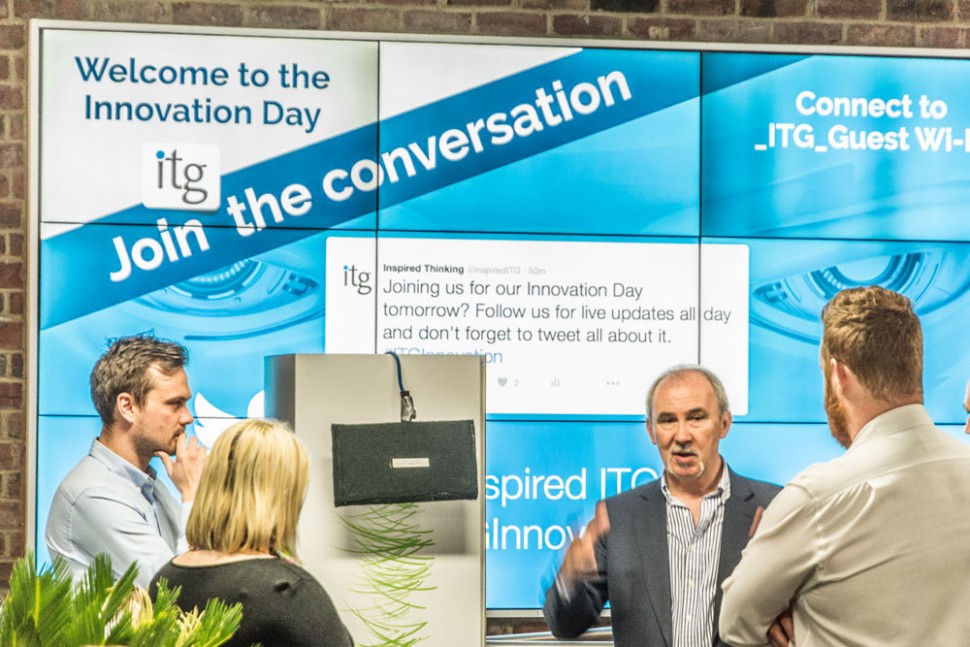Marketing
-
When inviting tenders from suppliers, you should always ask: “If your existing supplier withdraws their service, how would you ensure business continuity?”
Your company may be obliged to review and retender its supplier contracts from time to time. Or maybe you’re not happy with your existing print supplier (or agency or props supplier). Nevertheless, divorcing them and finding someone new can be a real headache.
After all, that marketing agency or print manufacturer might have let themselves go a bit. But at least they understand your quirks. Your likes and dislikes. Even if they don’t always go along with them.
Add to this the risk of a failure in supply if the divorce gets messy, and you could be moving from a business continuity issue to disaster recovery.
Mitigating risk
Let’s say you put £25 million in print a year through your main print supplier. That’s a lot of work for them to lose, and they’re unlikely to be happy about the loss.
They may hold significant assets and imagery of yours that suddenly become difficult to find. Their presses might suddenly become very busy. They may just tell you they’re not interested in a smooth transition to your new supplier, helping to bed them in and handing over the work project by project.
If they simply walk away, can your new supplier pick up the pieces on day one?
New supplier responsibilities
We’ve transitioned in the region of £250 million of print to our supply chain over the past five years. That means we understand how much incumbent suppliers vary in their willingness to play ball with smooth transitions.
We know that an airtight disaster recovery plan to ensure business continuity is essential during a handover between suppliers. Our experience has given us a certain expertise in business continuity – and your new supplier should have that expertise, too.
Requests for proposals (RFP) tend to focus on normal delivery conditions. However, you need to know before you appoint a new supplier how they would cope under extraordinary conditions.
Business continuity plan
Whatever timescale you agree with your new supplier, you should receive guarantees that they can activate their business continuity plan immediately should the supply chain fail.
This should include:
• Full production capacity and capability from day one
• Plan in place to transfer stock to a fully operational warehouse in a timescale that causes no disruption to logistics
• Pre-agreed and named transition team able to be in place from day one
• Ability to deploy any software required to replace an incumbent’s, should this be required
Following this immediate response, you need to ensure that the potential supplier also has a tested plan in place that covers areas (in the case of print) such as materials availability, communications, stock information, data requirements, and much more. Different types of supplier need to cover different areas.
Probably most importantly, they shouldn’t charge you a premium to deliver early. At the proposal stage, ensure their commitment to being fully transparent and guaranteed pricing in the event you trigger the disaster recovery plan during the transition.
Ideally, you want a civilised divorce from your incumbent supplier, where no one talks about disaster recovery.
Nevertheless, if you don’t interrogate your prospective suppliers’ business continuity plans during the RFP process, you may be courting disaster.
-
People talk about ‘Death by PowerPoint’, but the biggest killer in marketing is not PowerPoint, but its Microsoft stablemate: the Excel spreadsheet.
Among the numerous big brands and retailers we consult with about helping them make their marketing operations more efficient, the most commonly occurring statement I hear is, “can you do anything about all these spreadsheets?” – usually accompanied by pulling out of hair and a sallow-faced, wide-eyed look of despair.
As it turns out, there is something we can do about it – but more about that later. First, what is it that makes marketers refer to their campaign spreadsheets by such affectionate names as the Spreadsheet of Doom or the Squares of Despair?
The first horror is version control. When companies run their campaigns and allocations via spreadsheets, there’s necessarily a requirement for several departments to be involved. Legion are the stories of departments all working off different versions, leading to the wrong assets being briefed, the wrong amount of print being ordered, and the wrong allocations being sent to stores.
Excel almost encourages easy mistakes. Delete one figure linked to a formula, and you can throw whole rows of important data out.
Checking and checking
There are also tortuously long checking processes to ensure all the information that has been put into a master spreadsheet by everyone from legal to HR to procurement is accurate and matches up.
“I’ve got a marketing degree,” I was told recently, “but I’ve just spent my afternoon running my finger over a spreadsheet.”
When you couple Excel issues with communications via email, with all the lack of visibility for anyone not in that particular chain, emails going into junk folders, and people never being able to find the right email, even when they have a vague recollection of receiving it, you have a recipe for errors and vast unnecessary duplication of effort.
Some of our recommendation to companies looking to us to help drive efficiencies is about process; the rest is about technology.
MRM efficiency
In an efficient marketing operation, the two go hand-in-hand. Manual campaign planning, email briefings and approvals, assets held on suppliers’ hard drives, store allocations spreadsheets (and guesswork) – all of these and more can be replaced by an efficient and flexible MRM platform.
Everything you require to run your operation is in one place, accessible to anyone with permissions, and with only one version of any data – the one within the system. All briefings, amendment and approval information is held in an easily accessible part of the software, rather than in the middle of a virtual forest of emails.
With the right MRM system, you can say goodbye to the Spreadsheet of Doom altogether – and get on with doing all those nice strategic things you dreamed of when you were doing your marketing degree.
Until next time
Simon Ward
About Simon Ward
Simon Ward ITG – Simon is the founder and CEO of pioneering technology-led marketing company, Inspired Thinking Group (ITG). ITG delivers best-in-class marketing software, procurement and studio services to dozens of blue-chip clients, including Audi, M&S, KFC, PUMA and Heineken.
Simon Ward SP Group – Prior to ITG, Simon founded SP Digital in 1998, and in 1999 bought SP Print to form SP Group, creating innovative marketing and point of sale displays for some of the world’s best-known retailers, including M&S, Sainsbury’s, Holland & Barrett and Calvin Klein.
-
We’ve known for a while that agile marketing – continuously developing and refining your marketing activity to improve your response to unfolding events and customer activity – can increase speed to market and foster more effective customer engagement than relying on those rigid old long-term marketing plans.
But to be truly agile, you need adequate data – from measuring the efficiency of your marketing operation to assessing customer sentiment and the effectiveness of your engagement across all digital and social channels. Knowledge really is power.
The problem most marketers face is not lack of data – every aspect of your digital activity generates reams of real-time information – but the ability to glue together these data feeds and interpret the information in a rapid and meaningful way.
That’s why we introduced Status. Status is our data visualisation and analysis tool, which complements our Media Centre MRM platform. It takes real-time data from all your marketing activity and presents it in an easy-to-read-and-interpret series of dashboards.
Instant insights
The faster you can access these insights, the more quickly you can assess what is working and use this intelligence to increase marketing performance, engagement and – what ultimately interests us all – sales.
Agile marketing often breaks down when information is either not shared by different teams due to siloed ways of working, or when third-party agencies retain the data. It also fails when your technology spits out information that other platforms can’t read.
Status solves these problems through being platform-agnostic. It can pull in data from marketing platforms such as our Media Centre, as well as numerous other sources, including Twitter, Facebook, SAP, Google AdWords, Google Analytics and Campaign Monitor.
It can combine marketing data with sales data, production, delivery and stock information, and financial and budgetary data, giving you total visibility of your entire operation.
Improved ROI
As a cloud-based app, Status enables you to view your real-time data on any desktop or mobile device. You can view broad overviews of activity or drill down to a granular level of information on any area of your operation.
Not only does Status provide valuable real-time insights, it helps you measure your return on investment by showing the impact of your campaigns on sales. You can see which channels work best at driving specific engagement, while the agility and insights it provides gives you more time to plan more effective campaign strategies.
But best of all, it’s easy to understand and navigate – you don’t need an IT degree to interpret the data and develop meaningful strategies. We supply it with expert training and setup, and ongoing development and support.
Until next time
Simon Ward
About Simon Ward
Simon Ward ITG – Simon is the founder and CEO of pioneering technology-led marketing company, Inspired Thinking Group (ITG). ITG delivers best-in-class marketing software, procurement and studio services to dozens of blue-chip clients, including Audi, M&S, KFC, PUMA and Heineken.
Simon Ward SP Group – Prior to ITG, Simon founded SP Digital in 1998, and in 1999 bought SP Print to form SP Group, creating innovative marketing and point of sale displays for some of the world’s best-known retailers, including M&S, Sainsbury’s, Holland & Barrett and Calvin Klein.
-
Marketing Week recently quoted advertising guru Sir John Hegarty as saying, “Brands are populated by people who don’t understand the basics of marketing.”
Is he right? And if so, is this the whole story? Simon Ward discusses.
Is Sir John Hegarty right?
Marketing Week quoted advertising guru Sir John Hegarty as saying that brands are “populated by people in thrall to technology” who “don’t understand the basics of marketing.”
The analysis seems a bit harsh.
Yet the argument is not without merit. He goes on to say, “big brand-driving ideas are few and far between”, and in this he makes a fair point.
However, while some of the blame for this may well fall on a lack of understanding in some marketing departments, my experience of dealing with numerous big brands is that the greatest blame must be laid at the door of growing complexity, not poor understanding.
The proliferation of digital channels and calls to connect with consumers across every single one, while guaranteeing compliance and accurately assessing the ROI of each, can leave marketers drowning in admin and processes.
As Sir John says, “creativity is fundamental to business growth”. But how is a marketer to come up with and constantly adapt big ideas when they’re swamped by process?
The sad truth is there are so many other calls on a marketer’s time because others in the C-suite prioritise instant ROI and feedback over pursuing long-term strategies and the much-needed big ideas. Few marketers have the time to prioritise the goals Sir John correctly identifies as being so important.
Unfortunately, with pressure on budgets and the demand for almost 24-hour reporting, things are not likely to change any time soon.
The answer, therefore, has to be to adapt to this changed environment. To find a way of enabling marketers to focus on the big idea without sacrificing the process and reporting that the board and shareholders demand.
The first thing that is required is to split the marketing function into those elements that are fundamental to developing creative strategy and those that are based around the mechanics of procurement, execution and reporting.
The second is to take everything in the latter category and automate and outsource the hell out of those processes so that, as far as possible, they’re removed from the marketer’s desk.
Technology has caused the problem; technology can provide the answer – whether it’s managing the mechanics of campaigns, dealing with procurement, or providing you with real-time campaign reporting via your mobile.When marketers are freed of those burdens, they will have the opportunity to show their mettle – to spend their time driving the brand forward through creativity.
Only when that happens will we truly know whether the fault lies in the dominance of process, or with the marketers themselves.Until next time,
Simon Ward
About Simon Ward
Simon Ward ITG – Simon is the founder and CEO of pioneering technology-led marketing company, Inspired Thinking Group (ITG). ITG delivers best-in-class marketing software, procurement and studio services to dozens of blue-chip clients, including Audi, M&S, KFC, PUMA and Heineken.
Simon Ward SP Group – Prior to ITG, Simon founded SP Digital in 1998, and in 1999 bought SP Print to form SP Group, creating innovative marketing and point of sale displays for some of the world’s best-known retailers, including M&S, Sainsbury’s, Holland & Barrett and Calvin Klein.
-
Keep creativity alive in a world of distraction
“Yes, I’m a marketing manager, but really I’m a project manager… I just don’t have the resource to be creative.”
I heard this comment from an audience member at a recent round table event hosted by The Drum, where I was invited to sit on the panel.
The title of the event was “When Marketers are not Marketers”, and joining me at the table were senior marketers from M&S, SABMiller and the IAB.
We all agreed that strong creativity leads to positive results in marketing, but we had to acknowledge that the time marketers have to be creative is severely restricted by the additional admin, procurement and reporting responsibilities that are increasingly piled on them.
The challenge for marketers, as Tina Kataria, SABMiller’s global category manager for agency sourcing, so succinctly put it, is to “keep creativity alive in a world of distraction.”
Improving the value of marketing
And these distractions are multiplying, driven by more digital channels, increasing accountability and ever-rising budgetary pressure. These budgetary pressures can lead to demands for cost cutting, which can be disastrous if not tied to increases in efficiency and improvements in the value of marketing activity.
There can be other fall-out too. As the IAB’s Steve Chester said, “cost-cutting can mean agency margins being squeezed, often leading to bad creative and driving down value.”
Adding to these issues, traditional notions of customer engagement and loyalty have been blown out of the water.“Customers are indifferent,” said fellow panellist Richard Jones, head of design and production at M&S. “That is the job marketing has to deal with.”
Overcoming this indifference and building brand engagement means devoting more time to creative strategy and customer engagement, not less. And this means reclaiming time and resource for creative thinking by reducing the admin burden.
So that’s the conundrum we discussed at length: how to increase creativity in the face of demands for greater efficiency and value, and the avalanche of admin and process. It’s a problem I encounter all the time, and fortunately it does have a solution.
Technology is key
Many of the time-consuming tasks that are taking marketers away from addressing the urgent needs of creatively encouraging customer engagement – managing campaigns, suppliers, assets, briefing, approvals – can be handed over to technology.
The panel had a very interesting discussion on the difference between those in marketing who understand the value of technology and those who don’t.
Technology impacts everyone in business, because it’s where the savings lie. The right marketing automation achieves the double hit of freeing up your time to focus on creativity – most likely why you got into the job in the first place – and delivering those cost savings demanded by the board.
Joined-up marketing
A joined-up approach to marketing operations that embraces technology can deliver hard savings through better and more transparent briefings and approvals, reducing reworks and delivery time.
It can provide improved adherence to CPAs, enabling you to do more in the time available, as well as providing the obvious major time and efficiency improvements by banishing spreadsheets and manual ways of working.You’ll see a reduction in emails for each job, and savings from reduced reliance on freelance resource.
Efficient automated workflows give you the extra time you need to properly plan and develop strategy, while the visibility technology can provide of your entire operation enables you to measure campaign effectiveness to facilitate better planning and budget allocation.
We concluded that there are, in effect, two streams to marketing: ideas-driven marketing and data-driven marketing.
The first relies on good people with inspirational ideas, good instincts and, crucially, the time required to develop creative strategies and put them into effect.
The second provides the operation efficiency, value and reporting required, but it is time-consuming unless supported by the right technology – technology that frees up time for the ideas-driven marketing that can overcome consumer indifference.
Perhaps when all companies take this approach, we’ll be able to come back to the Drum for an event entitled “When Marketers ARE Marketers”. I look forward to the day.
Until next time…
Simon Ward
You can read The Drum’s write up of the event.
About Simon Ward
Simon Ward ITG – Simon is the founder and CEO of pioneering technology-led marketing company, Inspired Thinking Group (ITG). ITG delivers best-in-class marketing software, procurement and studio services to dozens of blue-chip clients, including Audi, M&S, KFC, PUMA and Heineken.
Simon Ward SP Group – Prior to ITG, Simon founded SP Digital in 1998, and in 1999 bought SP Print to form SP Group, creating innovative marketing and point of sale displays for some of the world’s best-known retailers, including M&S, Sainsbury’s, Holland & Barrett and Calvin Klein.
-
Simon Ward explains how, by using Media Centre and SP, Inspired Thinking Group has solved the conundrum of local marketing.
As your company grows, and operations silo, having a complete view of your marketing activity becomes increasingly difficult. You may find ways of running a slick national marketing operation, but what about your local outlets?
Local stores make up large retailers’ bricks and mortar frontline, and progressive companies are finding that investing a bigger part of their budget in local marketing can reap enormous benefits: basing campaigns on local knowledge of customer demographics and preferences can deliver big ROI rewards.
The downside is you can lose visibility and control. Keeping your national activity joined up is tough enough, but how do you ensure your local managers come up with intelligent local marketing strategies and produce only on-brand assets?
Added to that, where are your local managers going to find the time to run a multichannel marketing campaign? They’re too busy trying to run a shop. This is the conundrum: if the only way you can get local marketing to work is to put in huge amounts of resource from central marketing, you might as well go back to a one-size-fits-all national strategy.
Making local marketing work
Over the years, Inspired Thinking Group has had a lot of time to work out how to unravel this knot. We work with brands that have large retail outlets – including car manufacturers Renault and SKODA – and those with smaller outlets, such as Weight Watchers, whose local leaders and meetings we support.
In every case, we have helped devise local marketing programmes that increase local footfall and sales, use guaranteed compliant assets and give complete visibility to the central team. As a bonus, local managers report increasing satisfaction with national marketing support as the programme matures.
How have we done it?
Key factors in local marketing success
Neither technology nor local marketing expertise on their own can unravel this knot. Both are required – and they have to work seamlessly together.
First, the technology. Local and national operations need a simple-to-use platform that stores all assets and can be viewed by all required parties. The software needs to be able to schedule campaigns, keep track of budgets and handle bespoke requests.
In 2010, we found exactly the software we needed in Media Centre by Total Marketing Services. Media Centre is an advanced marketing resource management platform built around core modules – Asset Library, Local Marketing, Workflow Manager, and so on – so marketers only need to invest in the functionality they need.
We were so impressed, we – sorry about the cliché – but we bought the company.
Six years of development later, Media Centre now sits at the heart of many of our clients’ marketing operations, with the Local Marketing module providing the means for local managers to run geographically relevant, compliant campaigns, with full visibility for central marketing.
Our Status Pro (SP) reporting app provides realtime campaign data on any desktop or mobile browser, combining Media Centre data with information from numerous other sources, including Google Analytics and social media activity, providing the ability for central marketing to drill down into the data to a granular level.
Central marketing creates and constantly updates a comprehensive suite of multichannel local templates that reflect national assets. These are stored in the client’s Asset Library and can be accessed through any browser. Every local manager can view, resize, amend and order any of the templated assets.
Service support
With the technology in place, the next thing is to look at service support. Local managers may not have the time or marketing expertise to run brilliant campaigns, so we provide expert local consultants who research the location, study the results of previous campaigns and recommend channel strategies for each outlet.
To ensure local executions are inexpensive, we also provide a Dynamic Template module in Media Centre that enables easy customisation of templated artwork directly through the browser. We also run a 24/7 artworking studio, dedicated to producing bespoke customisations of on-brand assets.
Our QC team ensures compliance of bespoke artworks, and all briefing, approvals, bookings and requests for quotes are handled through Media Centre.
An ITG account manager or account team works full time at the client’s head office, and is the first point of contact for all Media Centre and local marketing activity.
The result is a constantly innovating local marketing programme that provides increased ROI, is on-brand, and mirrors national executions. With the extra advantage that it requires no painful admin input from either local managers or national marketers, enabling them to spend their time doing what they do best – developing creative marketing campaigns or running stores.
Read our Renault local marketing case study here
Until next time,
Simon Ward
About Simon Ward
Simon Ward ITG – Simon is the founder and CEO of pioneering technology-led marketing company, Inspired Thinking Group (ITG). ITG delivers best-in-class marketing software, procurement and studio services to dozens of blue-chip clients, including Audi, M&S, KFC, PUMA and Heineken.
Simon Ward SP Group – Prior to ITG, Simon founded SP Digital in 1998, and in 1999 bought SP Print to form SP Group, creating innovative marketing and point of sale displays for some of the world’s best-known retailers, including M&S, Sainsbury’s, Holland & Barrett and Calvin Klein.
-
Simon Ward explains how a day can make a big difference to marketers – especially when it’s dedicated to innovation.
I’ve always been immersed in technology. As CEO of SP Group’s digital arm, I was at the cutting edge of what was on the face of it a very traditional industry – printing.
At ITG, our core offering is based around automation technology, and we’ve just taken our first steps into the big data arena, with our recent addition of ITG Creator.
But even people who run technology companies can struggle to keep up with every development – the time investment can be daunting, especially as not every invention will make it off the drawing board.
Pace of change in technology
It took decades for telephones to reach 50% of the population. It took five years for mobiles to achieve the same penetration. Innovation is not only getting faster, so is its adoption.
Companies with a competitive technology edge are better placed to attract customers than those who are baffled by technology. But there are so many areas of innovation out there, how is a marketer to find the time to keep up with them all?
We decided to help.
Over the past week, our offices have been teaming with clients. This was an innovation for us – generally we only entertain one or two clients at a time. However, over 140 clients, most of them marketers, visited our offices together, but it wasn’t just to see us. We’d invited some guests.
An appetite for innovation
Augmented reality, 3D printing, virtual reality, 360 degree cameras, interactive video, HyperSound technology – there are a huge number of technologies designed to improve retail customer engagement. We sought out the best, and invited their keepers to demo them for our clients.
Marketers from Heineken, Puma, Tesco, Boots, Sainsbury’s and numerous other retailers and brands moved from area to area, scrutinising innovation after innovation, interrogating the technology, and putting faces to buzzwords.
It’s not the most obvious tactic for a technology company, to showcase other people’s products alongside your own. But building a partnership with your clients is about more than simply selling your wares – it involves providing added value, just as they aim to give added value to their customers.
It was an exceptionally successful day, eliciting numerous positive comments. But perhaps the most satisfying were from those who said, “I knew about this technology, but until I saw the demo I didn’t realise it was for us.”
This shows that even marketers who keep up with technological innovations rarely have the time to delve deeply enough to see all the angles. Even when you attend technology exhibitions, you often spend a lot longer tracking down items of interest than you do experiencing the innovations.
A single day spent looking at a dozen specially selected technologies, with the ability to question experts in a relaxed and engaging environment, can give you a significant catch-up.
It’s certainly something we’ll be doing again.
Until next time
Simon Ward
About Simon Ward
Simon Ward ITG – Simon is the founder and CEO of pioneering technology-led marketing company, Inspired Thinking Group (ITG). ITG delivers best-in-class marketing software, procurement and studio services to dozens of blue-chip clients, including Audi, M&S, KFC, PUMA and Heineken.
Simon Ward SP Group – Prior to ITG, Simon founded SP Digital in 1998, and in 1999 bought SP Print to form SP Group, creating innovative marketing and point of sale displays for some of the world’s best-known retailers, including M&S, Sainsbury’s, Holland & Barrett and Calvin Klein.
-
Simon Ward discusses marketing resource management and return on investment.
Last year, Harry in sales brought 20x his salary and costs into your business. When things get tough, you’re not going to get rid of Harry. I’d happily employ Harry myself at Inspired Thinking Group.
But when the budget axe swings, whose head is going to roll off the block first?
In marketing, your neck can sometimes feel likes it’s sitting a little too close to the basket for absolute comfort. It’s not hard to see why. Everyone knows marketing helps bring in leads, helps keep your customers engaged and persuade them to invest in your wares. But if you can’t measure them accurately, it’s harder to make the case for keeping your neck in one piece than it is for Harry.
Marketing Resource Management
Innovative programmes and initiatives that make you stand out from the crowd can be slashed on a whim when efficiencies are on the table (and efficiencies should always be on the table). So what can you do?
Well, if marketing is going to continue to do great things for the company, it’s going to have to take a leaf out of Harry’s book and get measuring itself. After all, who knows what portion of Harry’s massive contribution should really be laid at marketing’s door? Perhaps you brought the customers to Harry, and Harry merely took the orders.
This is where marketing resource management (MRM) systems come in (you can find out more about ITG’s Media Centre here). MRM can help you measure things you weren’t able to measure before, on top of numerous other benefits.
Return on Investment
Garden-variety ways of measuring marketing ROI include brand awareness and intent to purchase, but a more valid ROI will look at savings from the process efficiencies and slashed operating costs afforded by MRM.
When you ally automation with an expert marketing services company, you save on staff time as well as process – and you can measure that saving accurately. With MRM, you can track budgets and engagement across every channel and better manage assets and campaigns – all of which can provide your purse-holders with meaningful ROI.
With measurable ROI comes a better appreciation of what marketing achieves for your company, increasing the Board and Finance’s satisfaction with your creative and spending decisions.
Not so smug now, are you Harry?
Until next time
About Simon Ward
Simon Ward ITG – Simon is the founder and CEO of pioneering technology-led marketing company, Inspired Thinking Group (ITG). ITG delivers best-in-class marketing software, procurement and studio services to dozens of blue-chip clients, including Audi, M&S, KFC, PUMA and Heineken.
Simon Ward SP Group – Prior to ITG, Simon founded SP Digital in 1998, and in 1999 bought SP Print to form SP Group, creating innovative marketing and point of sale displays for some of the world’s best-known retailers, including M&S, Sainsbury’s, Holland & Barrett and Calvin Klein.
-
A little over twelve months ago, we were pleased to welcome Heineken as a client. One of the most celebrated brands in the world, the prestigious Dutch brewer runs marketing campaigns across the globe, and Inspired Thinking Group (ITG) was tasked with adapting its below-the-line assets for 178 nations.
Our specialism in local marketing – tailoring national campaigns and assets for often hundreds of individual outlets – was a perfect fit for Heineken. And ITG had the opportunity to demonstrate that oceans and continents, languages and cultures, were no barrier to successful localisation.
Round-the-clock services
But there is another aspect of our business that would benefit our new partner. Our artwork and packaging studio operates 24/7. We are, as it were, ‘always on’ (find out more about Inspired Thinking Group’s studio)
This has proved extremely popular with our UK clients. They know if the work is urgent, they can send us a brief in the afternoon and receive the artwork the following morning – all managed effortlessly through our cloud-based Media Centre platform.
But one chap’s morning is another chap’s evening, and when you’re a company that’s rapidly expanding its services around the globe, you can hardly down tools at 5.30pm Greenwich Mean Time and expect to prosper in a world that never sleeps.
Quality artwork
To speed of content creation and global convenience, add quality. Most mistakes are made when people rush. If you’re scrambling to finish that poster or packaging design before the whistle blows, that’s when the ball gets dropped.
But when there’s another team you can pass the ball on to, the scrambling ceases and calm professionalism prevails. 24/7.
Until next time…
About Simon Ward
Simon Ward ITG – Simon is the founder and CEO of pioneering technology-led marketing company, Inspired Thinking Group (ITG). ITG delivers best-in-class marketing software, procurement and studio services to dozens of blue-chip clients, including Audi, M&S, KFC, PUMA and Heineken.
Simon Ward SP Group – Prior to ITG, Simon founded SP Digital in 1998, and in 1999 bought SP Print to form SP Group, creating innovative marketing and point of sale displays for some of the world’s best-known retailers, including M&S, Sainsbury’s, Holland & Barrett and Calvin Klein
-
Simon Ward discusses the many reasons a company might rebrand, some admirable, some less so.
The dreaded rebrand
For instance, a company’s reputation may have become tarnished through their own activity, and they look to rebranding as a way of projecting a fresher face to their customers and investors.
Sometimes companies go through a rebrand without any attempt to tackle deeper issues, in the hope that a slap of paint will solve their woes.
In some instances, it’s hard to avoid the suspicion that someone in the organisation is bored with its current image and wants to make a mark by changing the company logo from a square to a circle.
It’s no wonder rebranding can come with a stigma attached. There are always those who will whisper: if it ain’t broken, why would they fix it?
The brand refresh
But there are also laudable reasons for re-evaluating your brand. Markets evolve rapidly, channels expand and change. Successful companies grow, become too big for their original skin and must cast off a previously beneficial cocoon to emerge a butterfly.
At ITG, we haven’t gone through anything so radical as a rebrand, but we have grown rapidly in the past six years and gone from a handful of like-minded individuals to over 360 employees, working in diverse areas, from digital to artworking studio, from software developers to account teams.
We have expanded our services, gained numerous new accounts. The opportunity for the senior management team to speak to everyone in the business individually is not what it once was.
When you grow rapidly, there is a danger of people becoming siloed, disconnected from your core ethos. We therefore judged the time was ripe for a full assessment of ITG. Take stock, as it were: does everyone in the company fully understand our ethos, what we’re trying to achieve? Does the face we project – our website, our communications – reflect the company we have become?
Outsourcing or insourcing
To answer this, we engaged external agencies to speak to our clients and conduct an extensive staff consultation, so we could receive an impartial understanding of how we are perceived and where we sit in the market.
It might appear ironic that a company such as ITG, which has carried out discoveries of this kind for numerous clients, should engage the services of external agencies. But no matter how clear your focus as a C-suite on your values and business drivers, you should never mark your own homework. It is always prudent to seek the services of someone outside the business, who can look at your offering with clear mind and fresh eyes.
This doesn’t mean we didn’t involve our own employees. Far from it. There were numerous discussions both internally and between internal staff and external agencies. We invited staff to consider the big questions: who are we? What do we do? Why should companies use our services? Is there anywhere we can do better?
Revisiting the ITG website
In truth, we were pleased to discover that external perception pretty closely matched our internal perspective: no need to change the shape of our logo, after all. But certain interesting elements did come to light.
Looking at the Inspired Thinking Group (ITG) website and our own marketing communications, we discovered that what was perfectly suited to what we used to be was starting to be left behind by what we were rapidly becoming.
We set about creating a new website, based on the answers to the big questions we had considered at length. We addressed other areas of our comms, some of which were merely tweaks to ensure everything we did accurately reflected who we are.
With the new website launched and our refresh complete, I’ve had more time to consider how useful the exercise was. My conclusion? The repositioning enhancements were well worth the effort.
However, even more significant was involving others in the organisation in strategically thinking about what we do. Every job gives the holder a unique insight into their specific area, and their feedback is invaluable. But more importantly, by engaging people across the company, it encourages everyone to take greater ownership of the brand and culture they help to create: these thing are as much theirs as yours.
And that’s an outcome I’d recommend to everyone.
Until next time…
About Simon Ward
Simon Ward ITG – Simon is the founder and CEO of pioneering technology-led marketing company, Inspired Thinking Group (ITG). ITG delivers best-in-class marketing software, procurement and studio services to dozens of blue-chip clients, including Audi, M&S, KFC, PUMA and Heineken.
Simon Ward SP Group – Prior to ITG, Simon founded SP Digital in 1998, and in 1999 bought SP Print to form SP Group, creating innovative marketing and point of sale displays for some of the world’s best-known retailers, including M&S, Sainsbury’s, Holland & Barrett and Calvin Klein










